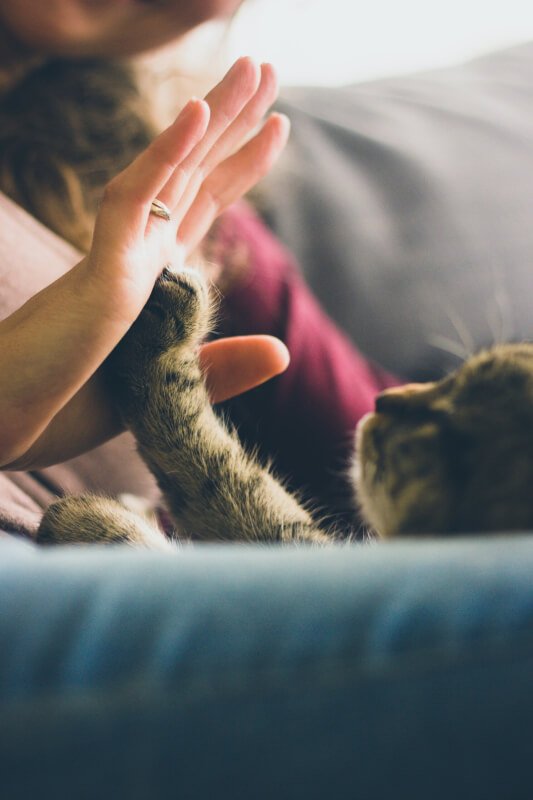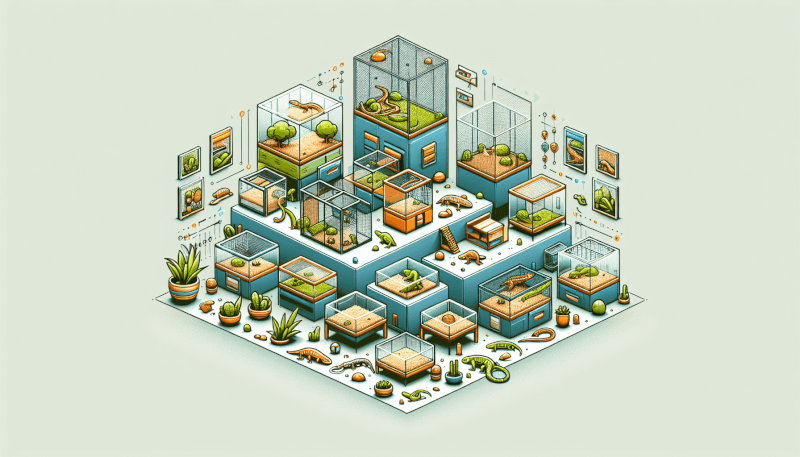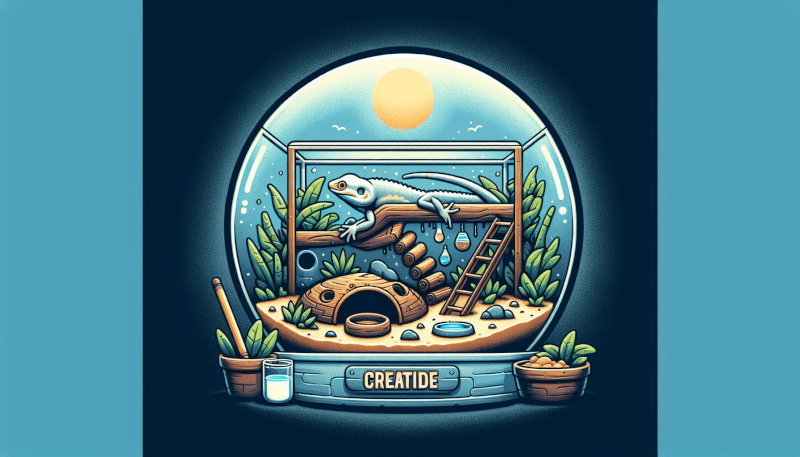Are you a reptile enthusiast or considering getting a reptile as a pet? If so, one of the most important decisions you’ll make is choosing the right enclosure for your scaly friend. In this article, we will explore the crucial factors to consider when selecting a reptile enclosure, focusing specifically on size and design. From the optimum size for your reptile’s comfort to the best enclosure design for their specific needs, we’ll guide you through the process of creating the perfect home for your reptilian companion. So let’s get started and ensure that your reptile has a comfortable and inviting space to thrive in!

Size of the Enclosure
When it comes to choosing the right reptile enclosure, size is a crucial factor to consider. You want to ensure that the enclosure provides enough space for your reptile to move around comfortably and exhibit its natural behaviors. Different reptile species have varying space requirements, so it’s essential to do thorough research or consult with a reptile expert to determine the ideal size.
Consider the Size of the Reptile
One of the first factors to consider when determining the size of the enclosure is the size of your reptile. Larger reptiles will obviously require larger enclosures to accommodate their size and provide enough room for movement. Smaller reptiles, on the other hand, may thrive in smaller enclosures. It’s critical to take into account the mature size of your reptile, as some species go through significant growth spurts and may outgrow smaller enclosures fairly quickly.
Provide Enough Space for Natural Behaviors
Reptiles have specific natural behaviors that they engage in regularly. Whether it’s climbing, burrowing, or swimming, it’s essential to provide enough space within the enclosure for your reptile to exhibit these behaviors. For example, arboreal reptiles like tree-dwelling geckos or chameleons will require vertical space with branches or vines for climbing, while terrestrial reptiles like bearded dragons may benefit from a larger ground area to move around.
Consider the Growth Potential
While it’s crucial to provide an enclosure that fits your reptile’s current size, it’s equally important to consider their growth potential. Some reptiles, such as snakes or lizards, can grow significantly throughout their lifetime. It’s best to plan ahead and choose an enclosure that can accommodate their potential growth, preventing the need for frequent upgrades in the future.
Account for Multiple Reptiles
If you plan on housing multiple reptiles in the same enclosure, you must size the enclosure accordingly. Each reptile should have enough space to establish territories, retreat to their hiding spots, and have access to food and water without competition. Additionally, it’s important to consider the compatibility of the reptiles you plan to house together to ensure they can coexist peacefully in a shared space.
Enclosure Design
The design of the reptile enclosure is another crucial aspect to consider. Different enclosure types offer various benefits and suit different reptile species and needs. Let’s explore some of the common types of reptile enclosures:
Glass Enclosures
Glass enclosures remain a popular choice among reptile owners due to their excellent visibility, which allows you to observe your pet easily. They also provide good insulation, helping to maintain the temperature and humidity levels within the enclosure. However, be mindful of ventilation requirements, as glass enclosures can sometimes trap heat and humidity.
Plastic/PVC Enclosures
Plastic or PVC enclosures are lightweight and easy to clean, making them a practical choice for many reptile keepers. They often come in modular designs, allowing for easy customization and expansion as your reptile grows. These enclosures offer good insulation and can mimic natural habitats effectively.
Wooden Enclosures
Wooden enclosures provide a more natural and aesthetically pleasing option. They can be customized with various features, such as built-in climbing structures or burrowing areas, to cater to specific reptile species’ needs. However, wood can be more challenging to clean and maintain compared to other enclosure materials.
Screen Enclosures
Screen enclosures are commonly used for reptiles that require ample ventilation, such as certain species of chameleons or tropical reptiles. These enclosures allow for excellent airflow and provide a more natural outdoor feel, but they may require additional insulation to maintain proper temperature and humidity levels.

Ventilation
Proper ventilation is essential for maintaining a healthy and comfortable environment within the reptile enclosure. Insufficient ventilation can lead to stagnant air, high humidity levels, and the buildup of harmful substances. Here’s why ventilation is important and how you can achieve it:
Importance of Proper Ventilation
Proper ventilation ensures the exchange of fresh air while removing stale air and any odors or contaminants within the enclosure. It helps prevent the accumulation of excessive humidity, which can lead to health issues like respiratory infections or mold growth. Adequate airflow also contributes to regulating temperature and preventing overheating.
Screened Tops for Airflow
One effective way to achieve proper ventilation is by using enclosures with screened tops. These screens allow for the natural circulation of air while still keeping your reptile securely contained. The mesh or screen material should be tightly woven enough to prevent any escape attempts while still allowing adequate airflow.
Vents and Air Holes
Additional ventilation can be provided through the use of vents or air holes strategically placed on the enclosure. These openings should be large enough to allow for proper airflow but small enough to prevent any potential escape. However, it’s important to strike a balance between ventilation and maintaining the temperature and humidity levels required by your reptile.
Accessibility
The accessibility of the reptile enclosure plays an important role in maintaining the enclosure and interacting with your reptile. Different types of enclosure openings offer varying levels of ease and convenience. Consider the following options when choosing an enclosure with optimal accessibility:
Front-Opening Enclosures
Front-opening enclosures are popular among reptile owners because they provide easy access to the enclosure’s interior. This design allows for convenient cleaning, feeding, and handling of your reptile without the need to disturb their habitat excessively. It also minimizes stress for more skittish or defensive reptiles who may be less comfortable with top or side access.
Top-Opening Enclosures
Top-opening enclosures provide a different approach to accessibility. They often come in the form of hinged lids or removable tops. While they may require more effort and maneuvering to access the enclosure’s contents, they can be a better choice for reptiles that are more arboreal or prefer climbing. Top access also allows for easy arrangement of lighting and heating equipment.
Side-Opening Enclosures
Side-opening enclosures offer a compromise between front and top access. They allow for easy access to the enclosure’s interior while still providing suitable options for placement of lighting and heating elements. Side openings can be beneficial for reptiles that require a larger opening for entry or exit, such as larger snakes or monitor lizards.
Sliding Doors vs. Hinged Doors
Enclosures with sliding doors offer a convenient way to access the enclosure without the need for additional space to swing open a hinged door. Sliding doors can be beneficial when working with limited space or when multiple enclosures need to be placed side by side. On the other hand, hinged doors provide a more secure closure, preventing accidental escape.

Visibility
The visibility of the reptile enclosure is an important aspect to consider, both for your enjoyment and for your reptile’s well-being. Depending on the species, some reptiles may prefer more privacy, while others thrive in highly visible environments. Consider the following options when choosing an enclosure that meets your reptile’s visibility needs:
Transparent Enclosures
Transparent enclosures, typically made from glass or plastic, provide excellent visibility, allowing you to observe and enjoy your reptile easily. This is particularly beneficial for those who want to showcase their reptile as a centerpiece or to educate others about these fascinating creatures. Transparent enclosures also allow for natural light to penetrate, which can positively impact your reptile’s overall well-being.
Privacy Options for Shy Reptiles
Some reptiles, particularly shy or nocturnal species, may prefer more privacy within their enclosure. You can cater to their needs by incorporating hiding places, such as caves, tunnels, or dense foliage, to provide them with a sense of security. Utilizing non-transparent materials for certain sections of the enclosure can also create a private space for these reptiles to retreat to when needed.
Ease of Cleaning
Keeping the reptile enclosure clean and hygienic is vital for your reptile’s health and well-being. Some enclosures can be more challenging to clean than others due to their design or material. Consider the following aspects when choosing an enclosure that offers ease of cleaning:
Removable Flooring
An enclosure with removable flooring or substrate trays can significantly simplify the cleaning process. Having the ability to remove and replace the substrate or flooring in one go reduces the need for excessive handling and provides a more efficient way of maintaining cleanliness. It also allows for thorough cleaning and disinfection when necessary.
Easy-to-Clean Surfaces
Choosing an enclosure with smooth, non-porous surfaces can make cleaning a breeze. Such surfaces prevent the accumulation of waste, dirt, or bacteria, and are easy to wipe down or disinfect. Avoid enclosures with textured surfaces or crevices that can trap debris and make cleaning more challenging.
Accessible Hides and Decorations
Ensure that any hides, decorations, or furnishings within the enclosure are easily accessible for cleaning. This includes removable or detachable hides, branches, rocks, or platforms that can be easily taken out, cleaned, and returned to the enclosure. Accessibility is key to maintaining the overall cleanliness and hygiene of the enclosure.

Temperature and Humidity Control
Temperature and humidity control is essential in maintaining a suitable environment for your reptile. Some enclosures come with built-in heating and cooling features or are compatible with specific equipment to help you regulate temperature and humidity levels effectively. Consider the following options when choosing an enclosure that allows for proper temperature and humidity control:
Enclosures with Built-in Heating and Cooling
Certain reptile enclosures offer built-in heating and cooling elements, such as heat mats, heat lamps, or cooling fans. These features make it easier to establish and maintain the ideal temperature range within the enclosure. They can be particularly useful for reptiles that have specific temperature requirements, such as tropical or desert species.
Enclosures with Mist Systems
For reptiles that require higher humidity levels, enclosures with misting systems can be highly beneficial. These systems provide a controlled mist that replicates the natural conditions of the reptile’s native habitat. The mist helps maintain proper humidity levels while also providing opportunities for your reptile to drink or enjoy a refreshing mist bath.
Compatibility with Heating and Lighting Equipment
If the enclosure you choose does not come with built-in heating or cooling options, ensure that it is compatible with the necessary equipment, such as heat lamps, ceramic heat emitters, or UVB lights. Consider the availability of sufficient space and proper placement areas for such equipment within the enclosure to create optimal temperature gradients and UV exposure for your reptile.
Security
Ensuring the security of the reptile enclosure is crucial to prevent any accidental escapes or unauthorized access. A secure enclosure provides peace of mind for reptile owners and ensures the safety of both the reptile and its surroundings. Consider the following aspects when choosing an enclosure with optimal security:
Locking Mechanisms
A sturdy and reliable locking mechanism is essential to prevent any accidental escape of your reptile. Look for enclosures with secure latches or locks that cannot be easily manipulated or opened by the reptile itself or small children. This is especially important for reptiles with high curiosity or a knack for escaping.
Escape-Proof Design
The design of the enclosure should also minimize escape opportunities. Make sure there are no gaps or openings that your reptile can squeeze through, and ensure that the enclosure’s walls or materials cannot be easily chewed or scratched through. It’s important to regularly inspect the enclosure for any signs of wear or damage that may compromise its escape-proof characteristics.
Avoiding Sharp Edges and Gaps
When selecting an enclosure, pay attention to any sharp edges or corners that could potentially harm your reptile. Smooth, rounded edges help prevent injuries and make the enclosure safer overall. Additionally, avoid enclosures with significant gaps between panels or areas where a reptile’s limbs or tail could get caught or injured.

Durability
Investing in a durable reptile enclosure ensures its longevity and provides a safe and secure habitat for your reptile. Consider the following aspects when choosing an enclosure with high durability:
Materials with High Strength and Resilience
Choose enclosures made from materials known for their strength and resilience. Common choices include high-quality glass, PVC, or high-density plastics. These materials can withstand the reptile’s activity, resist impacts, and prevent potential damage caused by sharp claws or teeth.
Resistance to Moisture and Corrosion
Certain reptiles require specific humidity levels, and enclosures may need frequent cleaning or misting. Choosing materials that are resistant to moisture and corrosion, such as treated wood or corrosion-resistant metal components, will ensure the enclosure’s longevity and prevent any degradation over time.
Longevity of Enclosure
Reptiles can have long lifespans, so it’s essential to invest in an enclosure that can withstand the test of time. Consider the quality of the materials, construction, and overall workmanship of the enclosure. Investing in a well-constructed enclosure may save you from having to replace it frequently.
Aesthetics
While functionality is essential, the appearance of the reptile enclosure can also play a role in aesthetics and overall enjoyment. Consider the following options when choosing an enclosure that matches your personal style and home décor:
Matching the Enclosure with Home Décor
Enclosures come in various designs, colors, and finishes, allowing you to find one that complements your interior design or personal preferences. From sleek and modern to rustic or naturalistic, there is an enclosure style to suit any home décor style. Finding an enclosure that aligns with your taste can enhance the overall look and feel of your living space.
Naturalistic Themes and Designs
Many reptile owners strive to create enclosures that replicate natural habitats. Enclosures with naturalistic themes, such as rock formations, faux vegetation, or realistic backgrounds, can enhance the visual appeal while providing a stimulating environment for your reptile. Naturalistic designs can also help create a more immersive experience for observers.
In conclusion, choosing the right reptile enclosure requires careful consideration of various factors. The size of the enclosure must accommodate the reptile’s needs, and the design should cater to its natural behaviors. Proper ventilation, accessibility, and visibility are crucial for the reptile’s well-being. The enclosure should be easy to clean, provide temperature and humidity control, and prioritize security and durability. Finally, the enclosure’s aesthetics can enhance both your enjoyment and the reptile’s overall habitat. By considering all these aspects, you can provide a suitable and comfortable home for your reptile companion.


